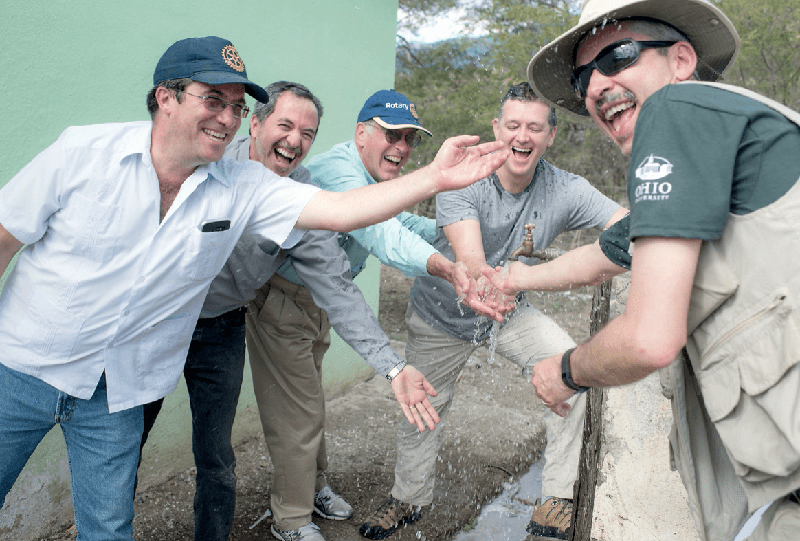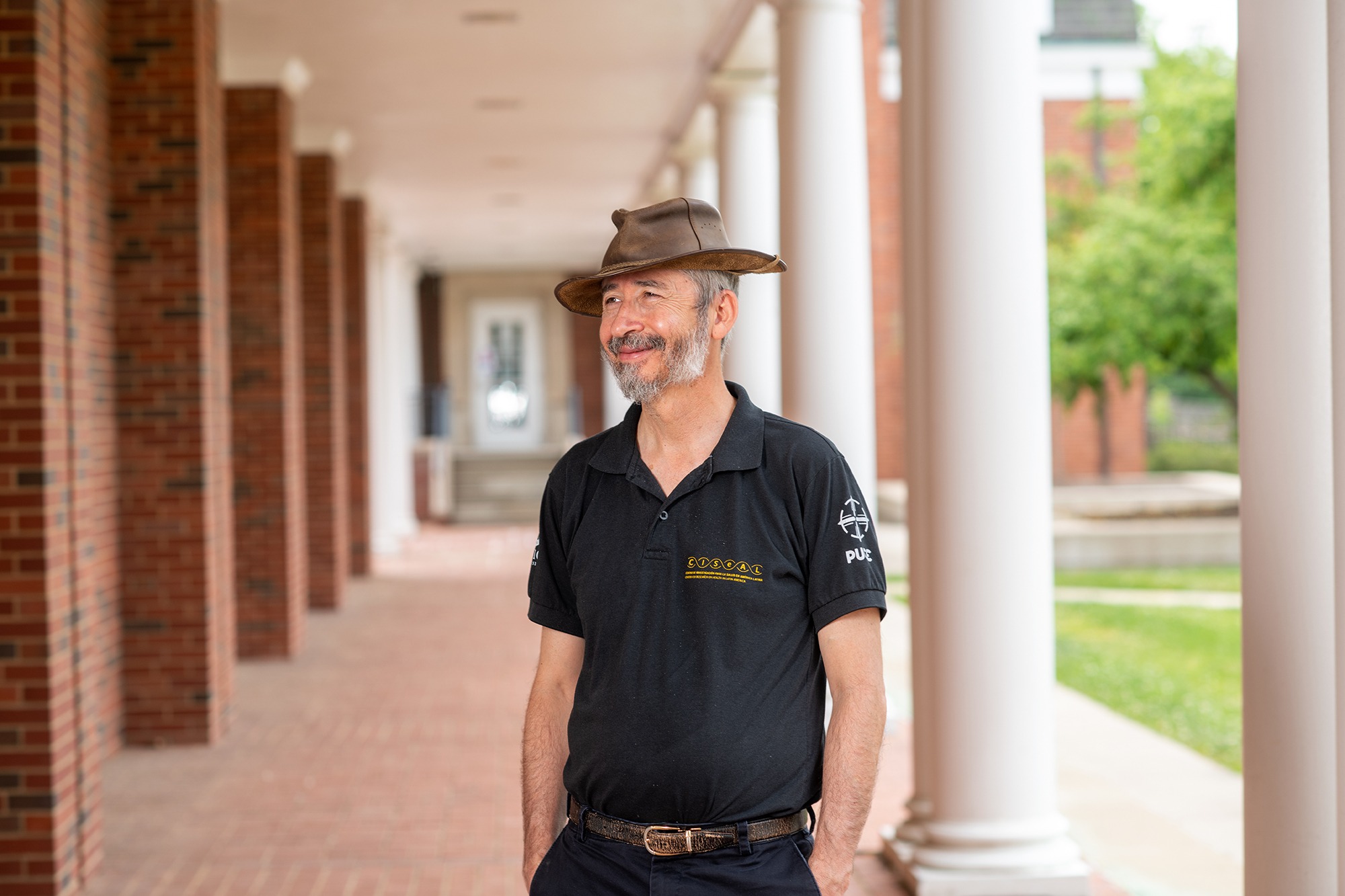Dr. Mario Grijalva, PHD ’97, joined the Heritage College of Osteopathic Medicine faculty in 1999 and has spent the past 15 years as director of OHIO’s Infectious and Tropical Disease Institute, established in 1987 to improve the health status of underserved populations.
A professor of microbiology and internationally recognized expert on the spread of infectious disease, he is one of the world’s foremost authorities on Chagas disease. The potentially lethal disease, transmitted by insects, affects millions primarily in Central and South America, including Grijalva’s native country of Ecuador.
Grijalva’s entire career—from his post-doctoral training with the Centers for Disease Control and Prevention to his recent work related to the COVID-19 pandemic—has been dedicated to researching and preventing infectious disease and to building a coalition to further those efforts.
He spearheaded the creation of the Center for Research on Health in Latin America (CISeAL), a collaboration between Ohio University and Pontifical Catholic University of Ecuador (PUCE), where Grijalva earned his undergraduate degree. Opened in 2000 and directed by Grijalva, the center, located in Quito, Ecuador, is home to one of Latin America’s most advanced research facilities.
Grijalva also serves as director of operations for the Healthy Living Initiative, employing a holistic and collaborative approach to fighting Chagas disease while building healthier communities in Ecuador. Through the initiative, students, faculty, staff and researchers from Ohio University, PUCE and CISeAL have partnered with community members to provide health education programs, build homes that are resistant to insect infestation, and combat issues of poverty that contribute to disease.
Ohio Today caught up with Grijalva to talk about his life’s work, his childhood dream of being a superhero scientist, and his biggest fear.
What made you want to pursue a career in infectious disease and to dedicate so much of your work to combating Chagas disease? During my undergraduate work at Pontifical Catholic University of Ecuador, I had done some research related to biochemistry and genetics, and, in particular, my undergraduate thesis was related to snake venom, which is considered a tropical disease not an infectious disease.
When I joined the laboratories at Ohio University, I learned about Chagas disease and the impact that it had on so many people. At the time, it was estimated that about 20 million people were affected by the disease, yet I had not heard about it. So, that spiked my curiosity. I started looking into the disease in Ecuador and around the world and found that there was a lot of need for research, information and awareness about the disease.
How has the Healthy Living Initiative helped prevent Chagas disease? One of the hallmarks of Chagas disease is that it is associated with poverty. The control programs that exist have been mainly from a reactive approach, spraying pesticides to get rid of the insects that transmit the disease and trying some level of prevention. But everything that is done has been very short term, at least in the areas where I work.
The Healthy Living Initiative is a project that tries to develop a new model of disease control based on empowering people to improve their lives through socioeconomic development and improvement of their housing conditions, and, through that process, you create conditions that are now not favorable for Chagas disease. If you have a better type of house and you are aware of the risk factors, you have the possibility of cutting the cycle of transmission forever.
Doing that is extremely difficult because it involves a multitude of factors that contribute to chronic poverty. Socioeconomic conditions on the local, national and international level, politics, infrastructure deficiencies at large, lack of access to health care and roads, lack of cohesiveness in the communities and many other issues all come together to create this perfect brewing caldron for the disease to be present. The Healthy Living Initiative tries to approach the problem from a multidisciplinary perspective, looking at the many ways in which external actors can help local communities recognize their value, recognize their capability for self-improvement and be a catalyst for structural changes that will lead to disease prevention in the long term.

Photo courtesy of Ohio University Heritage College of Osteopathic Medicine
Tell us about the Center for Research on Health in Latin America and your vision for it? When I finished my education at Ohio University, I wanted to go back to my home country in Ecuador to apply what I learned, but there was not an institution that could use my newly acquired skills. So, I started creating such an institution, so that future generations of scientists had a place to go back to and could contribute to disease control and prevention.
I started the center in the year 2000 as a collaboration between Ohio University and Pontifical Catholic University of Ecuador. The center is housed in a dedicated 100,000-square-foot, research-only facility that conducts state-of-the-art research into infectious and non-infectious diseases and involves faculty and students from Ohio University and the Pontifical Catholic University of Ecuador, as well as other institutions throughout the region and the world. The center is a platform for international collaboration that brings people together in a propitious environment to create the kind of research that is needed.
Have you been involved in any research and/or response efforts related to the COVID-19 pandemic? Very much. In Ecuador, our center started supporting national efforts for polymerase chain reaction (PCR) diagnosis (considered the gold standard for diagnosing COVID-19). We have conducted more than 150,000 PCR tests mainly for people who could not afford them and also for hospital workers and health care personnel from public institutions across the country. I have also been involved in multiple studies about the knowledge, attitudes and practices toward COVID-19 prevention. Those have been conducted in North and South America as well as in Ohio. So far, I think I have about six publications related to COVID.
As a child, what did you first want to be when you grew up? One of my earliest memories was wanting to be a superhero scientist. I would, in my imagination, help people through science. My parents encouraged me on that, especially my mom, and I became a biomedical researcher.
If you were granted three wishes, what would they be? Peace and prosperity for all humankind, but on a more practical level, I would wish that as a people we could reach a better equilibrium in terms of equality and inclusion and an understanding of the richness that our multilevel diversity brings or has. We have so many cultures, languages and potentials for creativity and acceptance.
The second wish would be, again as a humanity, to have a better understanding of our own biological processes and take better care of our Pachamama, which in Quechua, the indigenous language from Ecuador, means mother earth.
My third wish would be to travel the world and explore the different beautiful geographies and cultures. … I very much enjoy mountain biking. Ohio University is located in paradise for mountain bikers. We have Strouds Run trails, Lake Hope trails and now the new Baileys Trail System, which is going to be the best and largest mountain-biking trail system east of the Mississippi.
What is your biggest fear? My biggest fear is that the radicalization of thought will push our society into intolerance and chaos.
What advice would you give to your younger self? In terms of more serious advice, it would be to be focused and persistent on pursuing long-term visions and goals and to strive for a better balance between work and family. That probably would be the most important advice: to dedicate more energy into having this balance between the professional world and pursuing a career and the betterment of humanity while taking care of my family and my interpersonal relationships.
Featured image: From his Irvine Hall laboratory to Ecuador’s Center for Research on Health in Latin America, Dr. Mario Grijalva has dedicated his career to fighting infectious disease. Photo by Ben Wirtz Siegel, BSVC ’02




